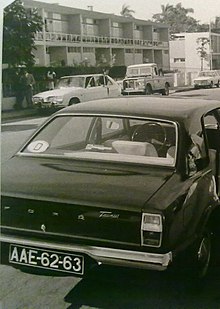History of Angola
The area of present day Angola was inhabited during the paleolithic and neolithic eras, as attested by remains found in Luanda, Congo, and the Namibe desert.
This changed at the beginning of the sixth century AD, when the Bantu, already in possession of metal-working technology, ceramics and agriculture began migrating from the north.
In 1482, Portuguese caravels commanded by Diogo Cão arrived in the Congo[1] and he explored the extreme north-western coast of what today is Angola in 1484.
The Portuguese brought firearms and many other technological advances, as well as a new religion (Christianity); in return, the King of the Congo offered plenty of slaves, ivory, and minerals.
By maintaining a policy of alliances with neighbouring states, he managed to hold out against the foreigners for several decades but in the late 1620s was eventually beheaded in Luanda.
After undertaking various journeys she succeeded in 1635 in forming a grand coalition with the states of Matamba and Ndongo, Kongo, Kassanje, Dembos and Kissamas.
Jinga entered into an alliance with the Dutch, thereby strengthening her coalition and confining the Portuguese to Massangano, which they fortified strongly, sallying forth on occasion to capture slaves in a later war.
Jinga's coalition then fell apart; the absence of their Dutch allies with their firearms and the strong position of Correia de Sá delivered a deadly blow to the morale of the native forces.
After Jinga died in 1663, the King of Congo committed all his forces in an attempt to capture the island of Luanda, occupied by Correia de Sá, but they were defeated and lost their independence.
[citation needed] Slave-trading routes and the conquests that made them possible were the driving force for activities between the different areas; independent states slave markets were now focused on the demands of American slavery.
[citation needed] In the high plains (the Planalto), the most important states were those of Bié and Bailundo, the latter being noted for its production of foodstuffs and rubber.
[2] The slave trade was not abolished until 1836, and in 1844 Angola's ports were opened to foreign shipping with the Portuguese unable to enforce the laws, especially dependent on English naval security.
Angola as a Portuguese colony encompassing the present territory was not established before the end of the 19th century, and "effective occupation", as required by the Berlin Conference (1884) was achieved only by the 1920s.
Trade in rubber and ivory, together with the taxes imposed on the population of the Empire (including the mainland), brought vast income to Lisbon.
[citation needed] The fall of the Portuguese monarchy and a favourable international climate led to reforms in administration, agriculture, and education.
However, Portuguese rule remained characterized by deep-seated racism, mass forced labour, and an almost complete failure to modernize the country.
The Portuguese regime, meanwhile, refused to accede to the nationalists' demands for independence, thereby provoking the armed conflict that started in 1961 when guerrillas attacked colonial assets in cross-border operations in northeastern Angola.
The Spínola government agreed to give all of Portugal's colonies independence, and handed power in Angola over to a coalition of the three largest nationalist movements, the MPLA, UNITA, and the FNLA, through the Alvor Agreement.
With the support of the United States, Zaïre and South Africa intervened militarily in favour of the FNLA and UNITA with the intention of taking Luanda before the declaration of independence.
With Cuban support, the MPLA held Luanda and declared independence as the Angolan People's Republic on 11 November 1975, the day the Portuguese left the country.
By the end of January 1976 the MPLA army (FAPLA) and the Cubans had all but crushed FNLA, Zairians and UNITA, and the South African forces withdrew.
In an effort to deliver a final blow to UNITA and to drive South Africa out of the country, in 1987 the People's Armed Forces for the Liberation of Angola (FAPLA), with Soviet support, launched a campaign fraught with failures and defeats.
From 30 October to 1 November 1992 the Halloween Massacre occurred in which thousands of UNITA and FNLA supporters in Luanda were killed by MPLA troops.
A national unity government was installed in April 1997, but serious fighting resumed in late 1998 when Savimbi renewed the war for a second time, claiming that the MPLA was not fulfilling its obligations.
The Angolan military launched a massive offensive in 1999 that destroyed UNITA's conventional capacity and recaptured all major cities previously held by Savimbi's forces.
A Russian freighter delivered 500 tons of Ukrainian 7.62 mm ammunition to Simportex, a division of the Angolan government, with the help of a shipping agent in London on 21 September 2000.
The Spanish government in the Canary Islands prevented a Ukrainian freighter from delivering 636 tons of military equipment to Angola on 24 February 2001.
The military commanders signed a Memorandum of Understanding as an addendum to the Lusaka Protocol in Luena on 4 April, Dos Santos and Lukamba Gato observing.
[22] Fernando Vendrell produced and Zézé Gamboa directed The Hero, a film about the life of average Angolans after the civil war, in 2004.
[26] In August 2020, José Filomeno dos Santos, son of Angola's former president, was sentenced for five years in jail for fraud and corruption.




